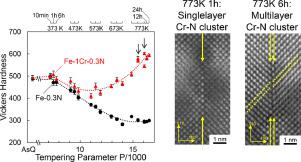Acta Materialia ( IF 8.3 ) Pub Date : 2020-12-30 , DOI: 10.1016/j.actamat.2020.116612 Shao-Wen Young , Mitsutaka Sato , Kazuhiro Yamamitsu , Yusuke Shimada , Yongjie Zhang , Goro Miyamoto , Tadashi Furuhara

|
The precipitation behaviors of alloy nitrides during the high-temperature tempering of Fe-0.3mass%N-1mass%M (M: Cr, Mo, Mn, or Si) martensite obtained by gaseous nitriding and quenching was investigated. Resistance to temper softening was observed with the addition of Mn, Cr, and Mo and secondary hardening occurred in the Cr and Mo alloys at tempering temperature above 673K although Si addition did not result in clear change in temper softening in comparison to the Fe-N binary case. X-ray diffraction analysis and conventional TEM observation shows the precipitation of iron nitride (γ'-Fe4N) and alloy nitride during tempering at 773K. Cs-corrected STEM-HAADF observation revealed that metastable mono-layered nitrogen-alloying element clusters are formed along {001}α' plane and they are eventually thickened into B1-type MN precipitate in the Cr and Mo alloys. In the Mn alloy, B1-type Mn nitride was detected which presumably changes to η-Mn3N2 by thickening. 3DAP analysis confirmed the ratio of nitrogen and alloying element of the nitride corresponds to the structure deduced by STEM-HAADF. Clustering analysis of 'matrix' indicated that there are still finer clusters which could not be clearly visualized in STEM-HAADF and 3DAP. Hardness after tempering was examined by strengthening by precipitation and dislocations, suggesting that undetected Cr-N clusters should contribute to hardening in the Cr alloy.
中文翻译:

合金元素对Fe-0.3N马氏体高温回火的影响
研究了通过气态氮化和淬火得到的Fe-0.3mass%N-1mass%M(M:Cr,Mo,Mn或Si)马氏体高温回火过程中合金氮化物的析出行为。加入Mn,Cr和Mo可以观察到抗回火软化的能力,并且在Cr和Mo合金中,在高于673K的回火温度下会发生二次硬化,尽管与Fe-N相比,加入Si不会导致明显的回火软化变化二进制情况。X射线衍射分析和常规TEM观察示出了氮化物铁的沉淀(γ'-铁4N)和773K回火期间的氮化合金。Cs校正的STEM-HAADF观测表明,沿{001}α'平面形成了亚稳态单层氮合金元素簇,它们最终被加厚成Cr和Mo合金中的B1型MN沉淀。在Mn合金中,检测B1型锰氮化物这大概改变至η-Mn系3 Ñ 2通过增厚。3DAP分析证实了氮与氮化物中合金元素的比例与STEM-HAADF推导的结构相对应。对“矩阵”的聚类分析表明,仍然存在无法在STEM-HAADF和3DAP中清晰显示的更好的聚类。通过沉淀和位错的强化来检查回火后的硬度,这表明未发现的Cr-N团簇应有助于Cr合金的硬化。











































 京公网安备 11010802027423号
京公网安备 11010802027423号